Key takeaways:
- The 1920s marked the invention of the theremin, introducing innovative approaches to sound interaction.
- Key techniques in electronic sound art include sampling, synthesis, and real-time manipulation, allowing for unique sonic expressions.
- Artists like Aphex Twin and Kaitlyn Aurelia Smith showcase the emotional depth and narrative potential of electronic sound art.
- The democratization of music production has enabled new voices to emerge, reshaping contemporary music dynamics.
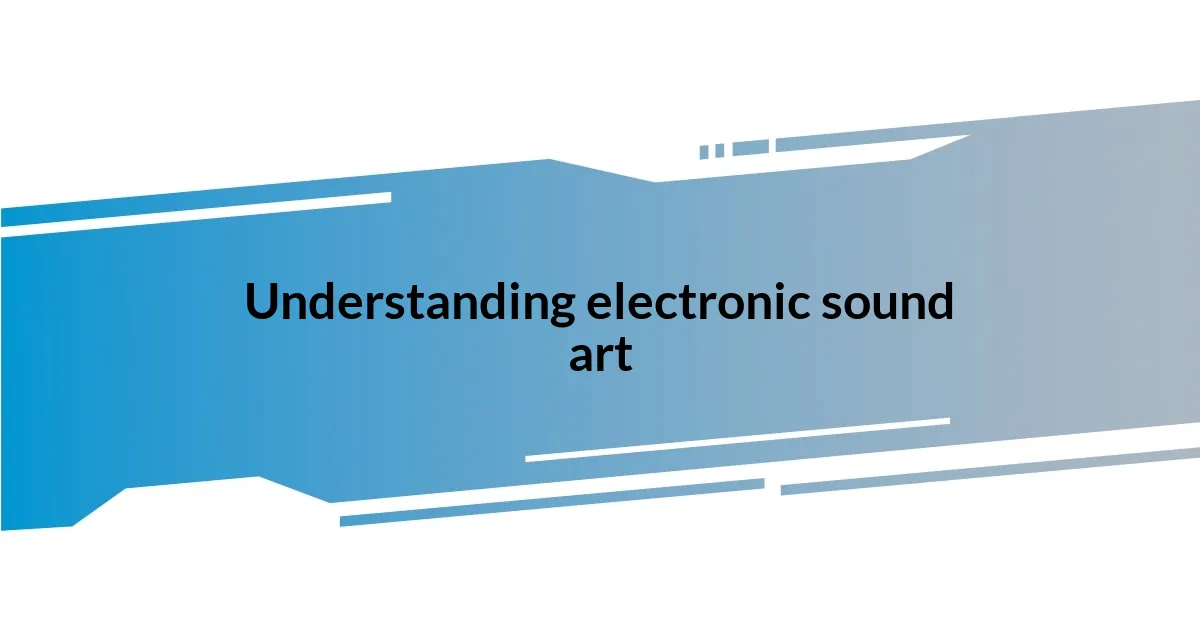
Understanding electronic sound art
Understanding electronic sound art requires more than just listening; it invites you to engage with the very essence of sound itself. I remember the first time I encountered an installation that used the hum of city life as a canvas. It struck me how those ordinary noises transformed into a profound auditory experience, prompting me to ask, “How can something so familiar feel so new?”
This art form stretches traditional boundaries, often merging music, visual art, and technology in unexpected ways. I find it fascinating how electronic sound artists manipulate frequencies and textures, creating layers that evoke emotion and provoke thought. Have you ever felt a chill listening to a piece that seemed to resonate with your own experiences? That’s the power of sound art; it speaks to vulnerabilities we might not even recognize in ourselves.
Ultimately, electronic sound art challenges us to reconsider what we define as “music” or “art.” I recall an exhibition where the interplay of light and sound transported me to a different realm. It made me wonder: are we merely listeners, or can we also become part of the artwork? Engaging with this genre opens a dialogue between the creator and the audience, inviting us all into the conversation of sound.
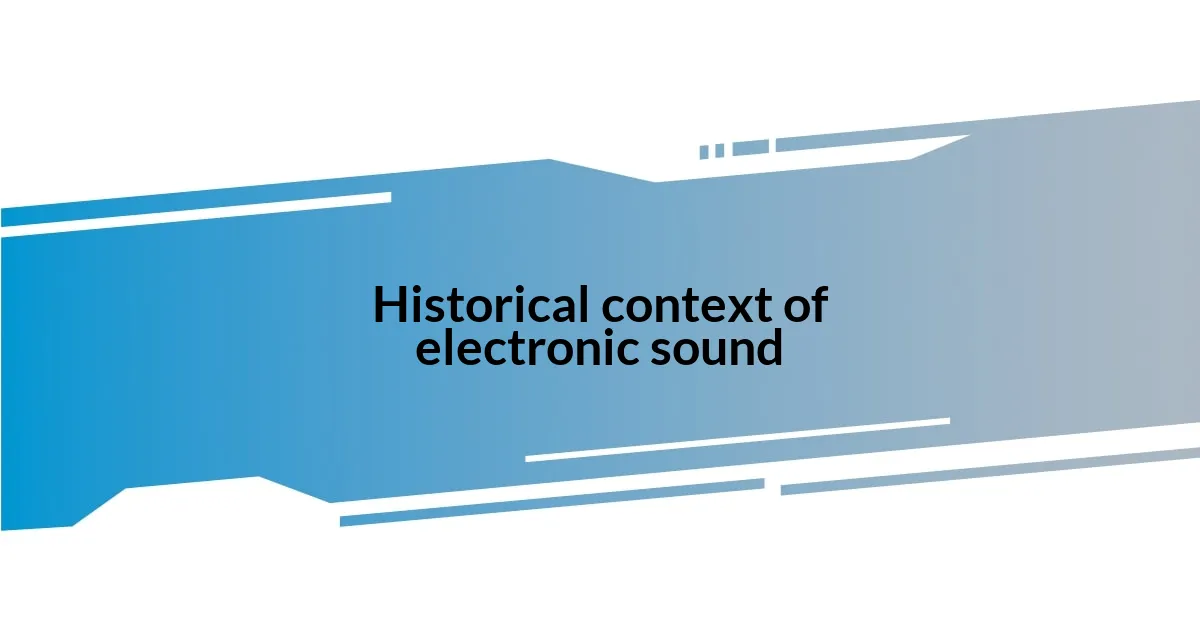
Historical context of electronic sound
The journey of electronic sound dates back to the early 20th century when pioneers began experimenting with the possibilities of electricity in music. I vividly recall the first time I heard about the theremin. This electronic instrument, invented by Léon Theremin in 1920, fascinated me with its eerie sound – it was played without physical contact. That moment made me grateful that visionaries explored sound as a frontier beyond traditional instruments.
- Key milestones that shaped electronic sound:
- 1920s: Invention of the theremin, introducing a new way to interact with sound.
- 1930s: John Cage’s interest in prepared piano, expanding the concept of using unconventional materials to alter sound.
- 1960s: Emergence of Moog synthesizers, allowing artists to create a wide range of sounds and textures.
- 1970s: Innovations in tape manipulation and the rise of electronic music in popular culture.
- 1980s and beyond: Digital technologies revolutionizing sound production, making it accessible to a wider audience.
Reflecting on these developments, I often think about my own journey into electronic sound. Attending a local music festival, I was captivated by a live performance that utilized an array of synthesizers and looping technology. The way the artist layered sound in real-time created an immersive experience; it felt like being enveloped by a warm blanket of auditory exploration. These historical context elements come alive in contemporary practices, reminding us of the innovative spirit that has always driven sound art forward.
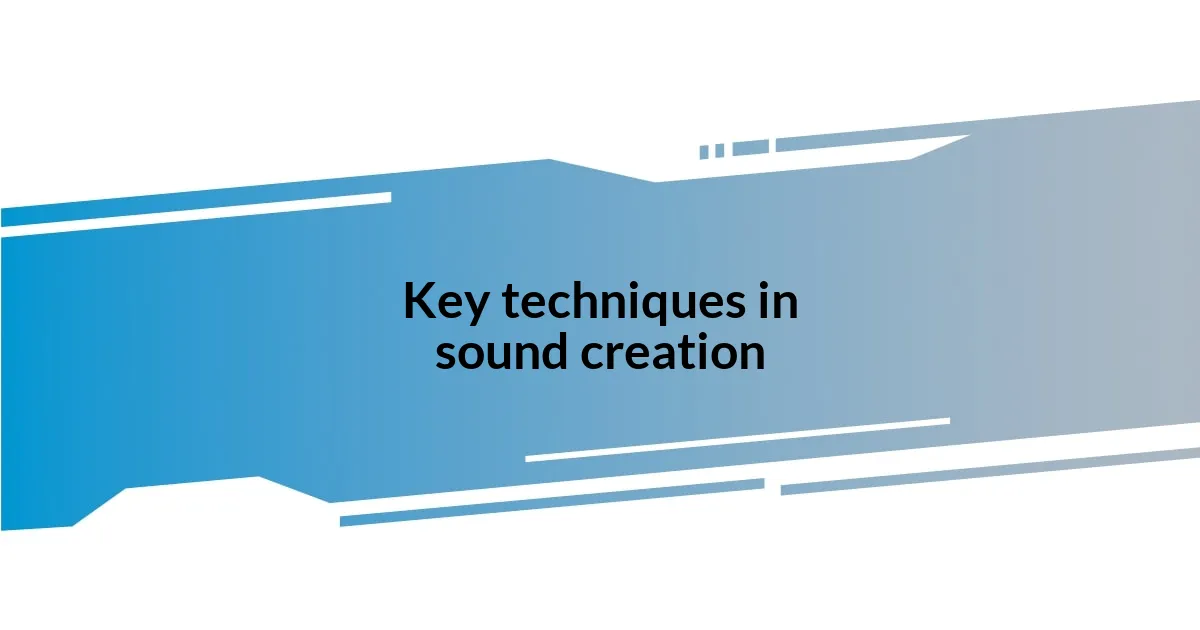
Key techniques in sound creation
Sound creation in electronic art can be a fascinating journey. One common technique is sampling, where existing sounds are taken from various sources and manipulated to create something entirely new. I remember the first time I experimented with sampling myself; I recorded snippets of everyday sounds—like the rustling of leaves and the clinking of glasses—and layered them to craft a sonic landscape. That moment opened my eyes to how mundane sounds could carry profound stories when treated with creativity and intention.
Another essential technique is synthesis, which involves generating sounds electronically using oscillators, filters, and envelopes. I distinctly recall my early sessions with a software synthesizer, feeling a thrill as I dialed in different parameters to shape timbres. The sheer possibilities felt limitless! This process allows artists to create sounds that don’t exist in nature, revealing a unique dimension of sonic expression that can evoke a wide range of emotions, from joy to melancholy.
We can’t overlook the process of real-time manipulation where artists interact with sounds as they’re being performed, utilizing tools like effect pedals and MIDI controllers. I once attended an event where a live coder altered the music as it played, weaving in unpredictable elements that kept the audience on their toes. This dynamic interaction is invigorating and offers a sense of co-creation, drawing the audience deeper into the experience as they witness the sound evolve in real-time.
| Technique | Description |
|---|---|
| Sampling | Using recorded sounds from various sources to create new compositions. |
| Synthesis | Generating sounds electronically, allowing for unique timbres and frequencies. |
| Real-time Manipulation | Live interaction with sounds and effects during performances. |
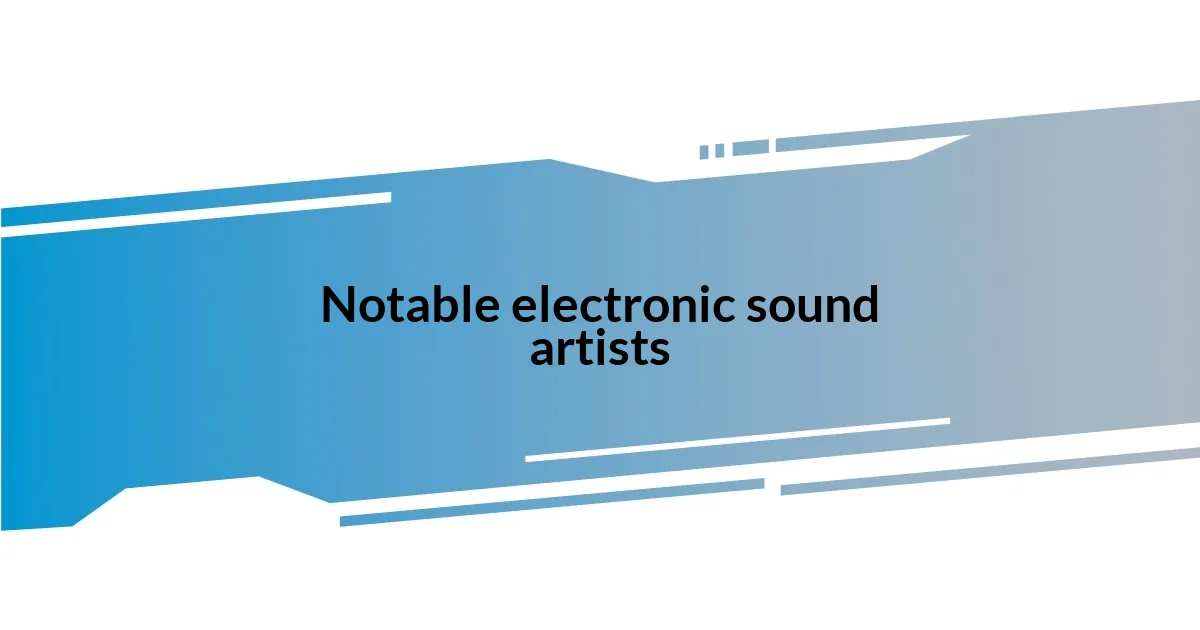
Notable electronic sound artists
One notable electronic sound artist who has shaped the genre is Aphex Twin, also known as Richard D. James. The first time I heard “Come to Daddy,” I was struck by its chaotic energy. His music feels like a journey through a labyrinth of sound; it challenges norms while inviting listeners to embrace unpredictability. Have you ever felt like you’re venturing into the unknown when listening to music? I certainly do with his work, as it often reflects a sense of both exhilaration and disorientation.
Another artist worthy of mention is Kaitlyn Aurelia Smith, whose compositions often evoke a deep emotional connection. I recall listening to her album “Ears” on a quiet evening, and it transported me to a different realm. Her unique use of modular synthesizers creates lush, organic textures that seemed almost alive. It made me ponder—how can sound evoke such vivid imagery and emotion? Smith’s art proves that electronic sound isn’t just about technology; it’s about storytelling through sonic landscapes.
Lastly, let’s not overlook Amon Tobin. I vividly remember that thrill I felt during his live performance, where he seamlessly blended genres while immersing the audience in rich soundscapes. His work, particularly with found sounds and samples, challenges our perception of music. He often asks us to reconsider the boundaries of musical genres, doesn’t he? In my experience, this ability to curate sound in unexpected ways is what truly makes Tobin a standout figure in electronic sound art.
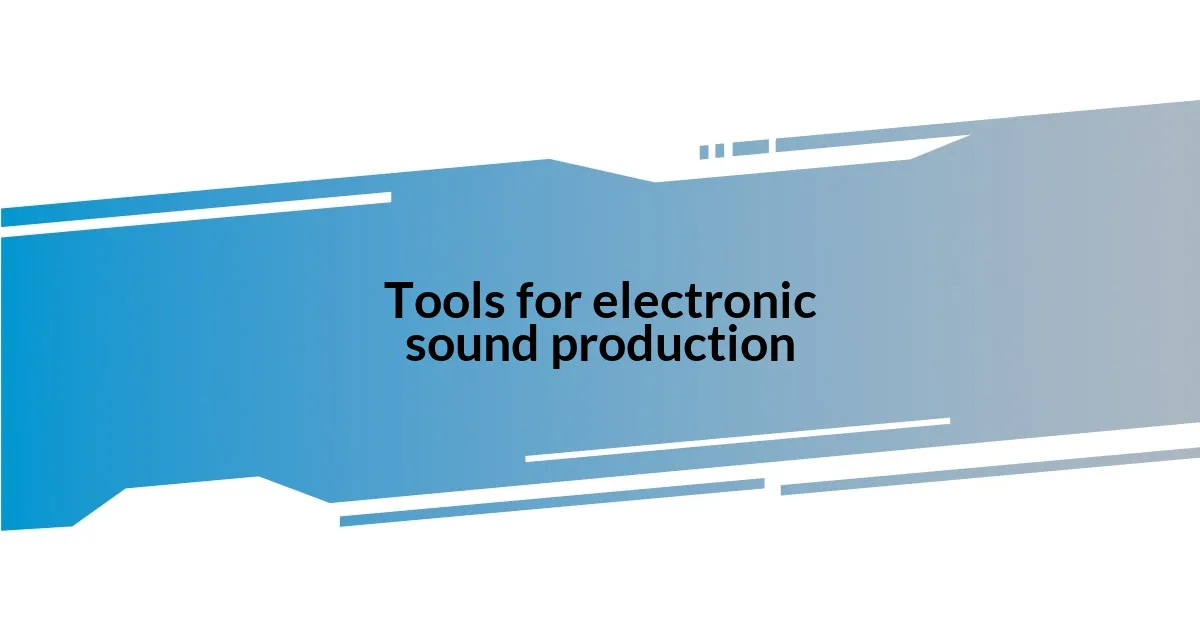
Tools for electronic sound production
When it comes to electronic sound production, the tools available can truly transform an artist’s vision into reality. One of my favorite tools to explore is digital audio workstations (DAWs). I remember diving into my first DAW, feeling a mix of excitement and intimidation. It was like stepping into an intricate playground of sound! With features that allow for multi-tracking, editing, and mixing, DAWs can empower anyone to realize their sonic ideas. Have you ever found yourself lost in the array of sounds and possibilities within a DAW? It’s a thrilling experience, to say the least.
Another essential tool in this realm is the midi controller, which offers flexibility and intuitiveness in performance. I’ll never forget the first time I connected my MIDI keyboard to a synthesizer plugin, and how every note I played felt like it brought the virtual world to life. It’s fascinating how physical interaction with a device can evoke emotions—I felt as if I was breathing life into my creations. MIDI controllers bridge the gap between artists and their digital environments, fostering real-time creativity that just can’t be replicated by mouse-clicking alone.
Finally, let’s not overlook the allure of modular synthesizers. The first time I encountered a modular setup at a friend’s studio, I was captivated by the sheer aesthetics of patch cables and blinking lights. The tactile nature of manipulating each module was exhilarating! It almost felt like a science experiment where every tweak led to an unexpected sound. Have you ever been drawn to an instrument so much that you forget everything around you? Modular synths encourage exploration, offering a playground for experimentation and personal expression that’s hard to resist.
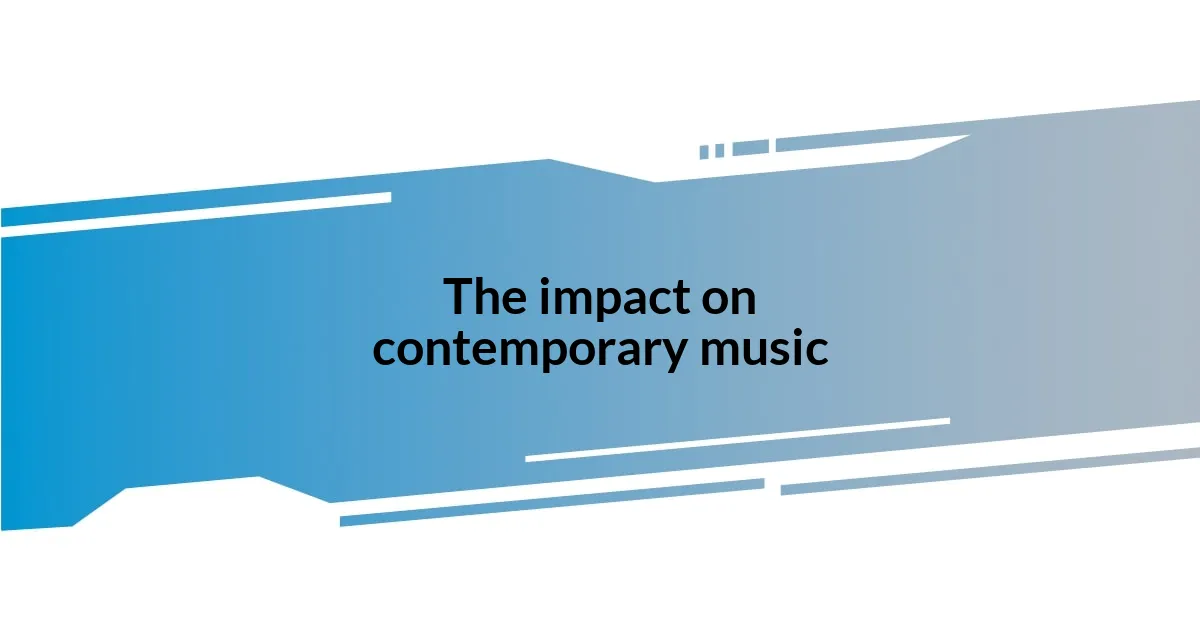
The impact on contemporary music
The transformative influence of electronic sound art on contemporary music cannot be understated. I remember sitting in a café, headphones on, as I delved into a meticulously layered track by Flying Lotus. The seamless blending of genres made me realize just how fluid music can be today. Have you ever experienced a moment when a song completely altered your perception of what music could be? It’s an exhilarating feeling, and it highlights how electronic sound art pushes the boundaries of genre definitions.
One striking aspect of electronic sound art’s impact is the way it encourages collaboration across genres. I once attended a local music festival where I was stunned by how a hip-hop artist collaborated with an electronic producer. The fusion created a vibrant atmosphere that showcased the best of both worlds. It made me reflect on how these artistic partnerships not only enrich the music but also broaden the audience’s experience. Have you noticed how this blending opens up doors to new sounds? The intermingling of styles is a testament to the creative possibilities that electronic sound art introduces into the contemporary music landscape.
Additionally, the democratization of music production fueled by electronic sound art has reshaped how we consume and create music. I’ve had friends who, inspired by accessible technology, started producing their own tracks from their bedrooms. This shift made me think about the new wave of artists emerging from unexpected places. It’s astonishing—have you ever considered how many unique voices might remain unheard if not for electronic tools? The barriers have lowered, allowing anyone with a passion to explore their sonic visions, which ultimately enriches the musical ecosystem.